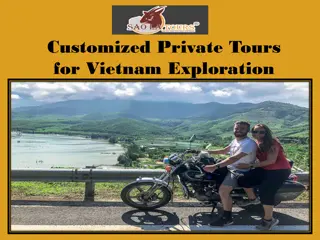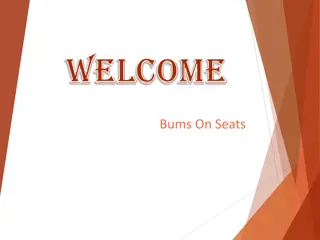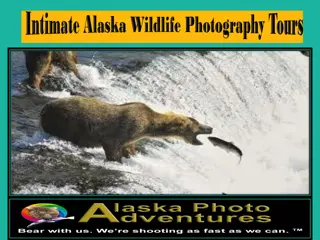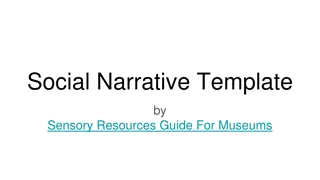Creating Descriptive Tours in Museums: A Comprehensive Guide
Dive into the world of creating descriptive tours for museum exhibits with a focus on emphasizing visible details, assisting visitors in navigating museum spaces, and enhancing the overall visitor experience through engaging itineraries and haptic dimensions. Learn about the importance of choosing source texts, selecting objects, and identifying meaningful itineraries to captivate and educate museum patrons of all backgrounds.
Download Presentation

Please find below an Image/Link to download the presentation.
The content on the website is provided AS IS for your information and personal use only. It may not be sold, licensed, or shared on other websites without obtaining consent from the author. Download presentation by click this link. If you encounter any issues during the download, it is possible that the publisher has removed the file from their server.
E N D
Presentation Transcript
DESCRIPTIVE TOURS MODULE 4 UNIT 8 ELISA PEREGO UNIVERSITY OF TRIESTE Dept. of Legal, Language, Translation and Interpreting Studies, Section of in Modern Languages for Interpreters and Translators University of Trieste, Via Filzi, 14 - 34144 Trieste, Italy Project numberStudies: 2016-1-IT02-KA203-024311 www.adlabproject.eu FUNDED BY THE ERASMUS + PROGRAMME OF THE EUROPEAN UNION
ADS AND DESCRIPTIVE TOURS Stand-alone ADs vs. descriptive tours. Both: Describe actual object. Emphasise visible details (e.g. size, shape, colour, texture, etc.). Address what cannot be seen (e.g. history, background info, etc.).
DESCRIPTIVE TOURS Coherent itinerary. Assist PSL to move from exhibit to exhibit. Help PSL to orient throughout the museum space.
BUILDING A DESCRIPTIVE TOUR Challenging: Ability to observe. Many people. Many stages.
VISITING AND SELECTING With internal staff and/or other experts. With blind patron(s). Take your time, take pictures. Take notes of your first impressions.
CHOOSING THE SOURCE TEXT Source text: objects and their relation to one another, the space and architecture of the museum/site, wider experience of visiting the museum/site.
CHOOSING THE SOURCE TEXT Attractive, unusual, arresting, meaningful objects Best represent the museum exhibition s narrative. Lend themselves to clear and vivid description.
IDENTIFYING AN ITINERARY Well planned and coherent. Meaningful and sequenced. Entertaining. Not too long.
HAPTIC DIMENSION Decide whether to add a haptic dimension to the tour via the introduction of: Braille or relief writing, tactile drawing boards or maps, replicas or bas-reliefs.
DOCUMENTARY RESEARCH Internal museum. Specialized literature. Exhibition material. Interviews.
DRAFTING THE AD Plan, write and edit as many times as necessary. Judge, rehearse, polish, prune away unnecessary details, and decide what is allowed to remain, just like in film script writing (Kozloff 2000).
ORIENT THE VISITOR Provide orientation instructions. Assist and encourage the visitors verbally. Make PSL feel comfortable, but free. Do not put pressure on PSL.
LAST BUT NOT LEAST Discuss with museum curators. Get feedback from PSL. Fine tune and finalise script
LIVE DESCRIPTIVE TOURS Annotated outline. Key words.
DESCRIPTIVE TOURS MODULE 4 UNIT 8 ELISA PEREGO UNIVERSITY OF TRIESTE Dept. of Legal, Language, Translation and Interpreting Studies, Section of in Modern Languages for Interpreters and Translators University of Trieste, Via Filzi, 14 - 34144 Trieste, Italy Project numberStudies: 2016-1-IT02-KA203-024311 Edited by: editor s first and last name www.adlabproject.eu FUNDED BY THE ERASMUS + PROGRAMME OF THE EUROPEAN UNION
The preparation of this presentation was supported by ADLAB PRO (Audio Description: A Laboratory for the Development of a New Professional Profile), financed by the European Union under the Erasmus+ Programme, Key Action 2 Strategic Partnerships, Project number:2016-1-IT02-KA203-024311.
The information and views set out in this presentation are those of the authors and do not necessarily reflect the official opinion of the European Union. Neither the European Union institutions and bodies nor any person acting on their behalf may be held responsible for the use which may be made of the information contained therein.























